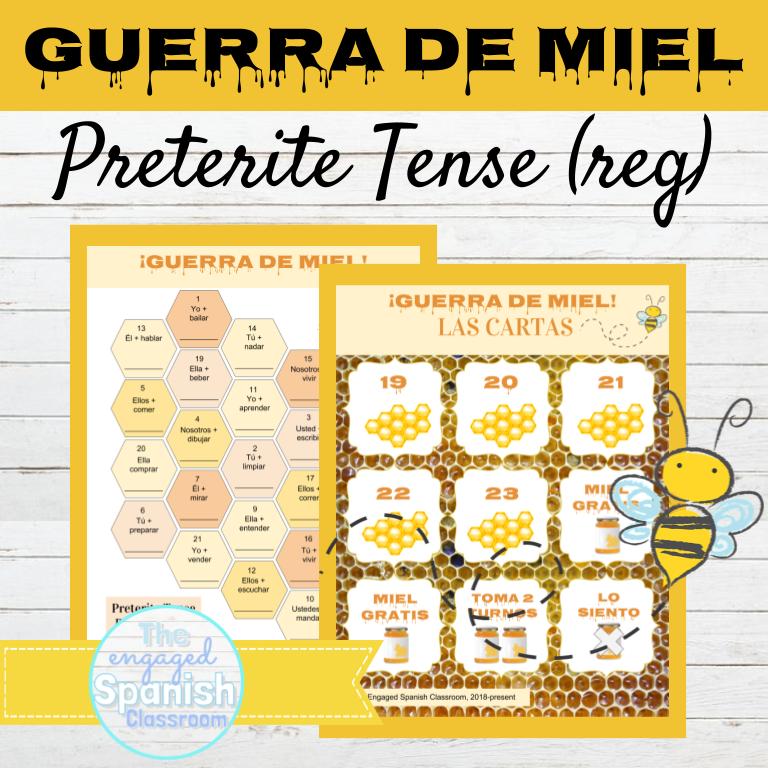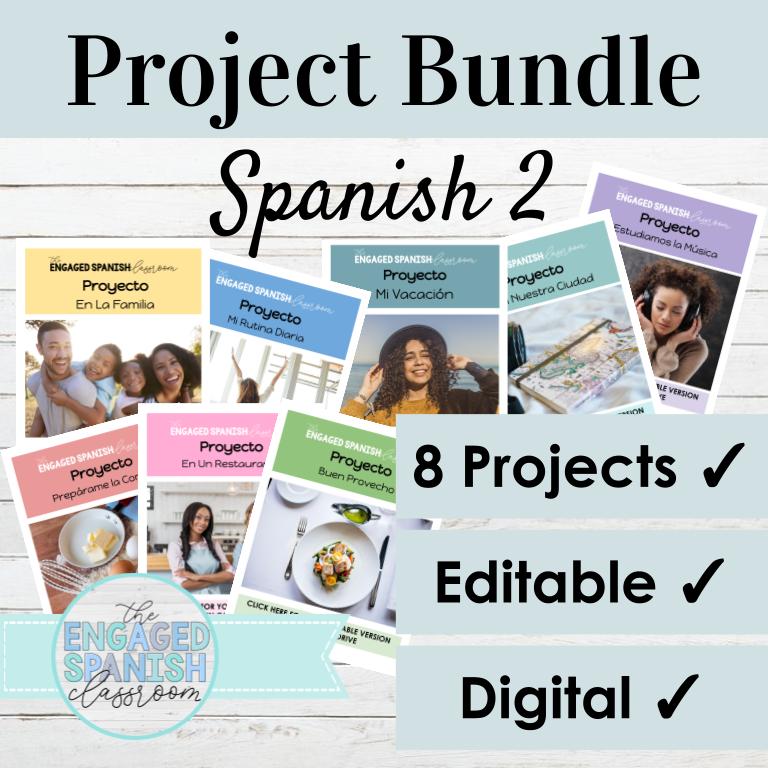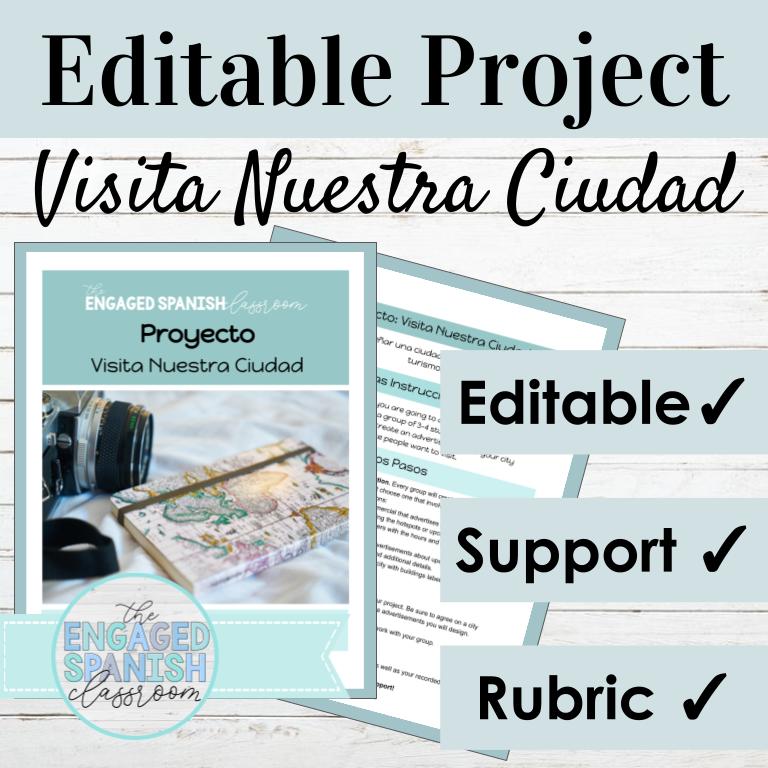As a new teacher I always struggled finding the right balance with review activities. When I was teaching directly out of the textbook (which I admittedly did for the first few years), the review activities were always either boring or too difficult…. but always draining. My students didn’t care about them, and frankly neither did I! It always felt like something we had to “get through.” If no one is enjoying what you’re doing… why do it?
I wanted to develop review activities and strategies that would be challenging for my students without being daunting. I also always want to promote target language use, and continually strive to do so in a way that builds confidence and keeps my students engaged. I tend to prefer small group activities over independent work by nature, so you’ll see a lot of those here, too!
I hope you can find a few new ideas or starting points to try with your students. I am still learning as I go each and every year, but wanted to share a compilation of my favorite review activities for Spanish 2! Keep reading to find:
- Review Games
- Whole Group Review
- Independent Activities
- “Assessment” Options
- Review Projects
These are the activities, assessments, and games that I come back to time and time again during review season.
Please note that for every activity you see, I have additional pre-made versions ready for you. If you see a game that you like, but wish it was for another topic or unit… check my categories on TPT. It’s very likely that I have one ready for you. If not, you can always contact me to make requests! For this post I have included examples for the preterite, imperfect commands, and more. I know that every Spanish 2 curriculum is unique, so I encourage you to visit my TPT to see if I have something that better matches your needs 🙂 Also, I offer editable templates so you can adjust mine / create your own review materials.
You can see my Spanish 1 Review Activities post here, and one for Spanish 3 right here. I also have a post all about my general review strategies here.
Review Games
Of course the first thing I always want to talk about is games. I use games as much as possible in my classroom; I have fun, my students have fun, and we stay in the target language in a low pressure setting. I love them for so many reasons!
During review season, games are a way to get my students to review while they think they are “just having fun.” In fact, they are being exposed to a LOT of comprehensible input, and they are expected to communicate in the target language – and they DO it! Not only do we accomplish these wonderful feats, but games also keep my students more engaged and help me avoid any end-of-year restlessness.
In Spanish 2, I find it is most important to keep students motivated. In my school, our Spanish 2 curriculum is one of the least…. fun. I’ll say it. It’s grammar heavy even when we don’t want it to be, and we cover so much that it’s har for us to find time to be flexible. Review games really help me to keep my students motivated, and to build positive relationships and trust with them.
Below are a few of my favorite review games for Spanish 2. I am inserting a wide variety here because they all offer different things, and are valuable for their own reasons! I also know that every Spanish 2 curriculum is very different depending on your unique school. And I’m also including a lot of options because, well, I love games. I hope you find a few that speak to you and help you and your students have fun together 🙂
And remember, these are samples of the styles of activity I use with this level. I have various pre-made versions of each one, and editable versions of many!
Taco Tuesday is of course my all time favorite. I love that I can now play digitally or in person! This partner or small group game gets very competitive and can be played for various lengths of time. See the tutorial for traditional gameplay here, and digital options here.
Panal de Preguntas is a game I made for a complete digital option. It can technically be utilized in many ways; in pairs or small groups, but even independently as well. Students are given the opportunity to practice reading and writing while also strategically blocking their opponents!
Tiburones is another great speaking game that is great for small groups of 3-4 students. I typically use this activity when we have at least 20 minutes, as students tend to like to play multiple rounds.
Guerra de Miel is an interactive card game for students to compete while conjugating!
Another similar option, Doble Donas, has an almost identical setup and gameplay except it provides an additional aspect of student choice at every turn.
Citas Cortas is another great speaking activity, and this one involves movement too! It’s my take on a speed-dating style speaking activity. There is a self-reflection attached to each version, which is especially important during review seasons!
Sonidos Secretos is a great morale booster. My classes always end up in giggles when we play. This may be one that has to wait for when social distancing and masks are no longer needed; but I couldn’t go without mentioning it here. It really is one of the most fun activities I have ever created for my students.
Read my tutorial post here to get a better idea of how to play!
Whole Group Review
Sometimes… whole class activities are best. It could be because certain classes need more structure, or it could be because you’ve noticed a common need/theme among your students. It might be that you were out the day before, and you need to regroup and assess where everyone is before making any other decisions about your lesson plans.
Whatever the reason, I always try to have a few big group activities in my back pocket for any unit. The activities below are meant for these days, and I hope they’re helpful for you and your students!
La Silla Caliente is one of my students’ favorite games every year. I love it because it is unique – a whole-group game where I can easily gauge how individual students are doing. You can read more about it in my tutorial right here.
I have pre-made game sets for a variety of tenses and vocab themes.
Four corners is great when you need a whole group activity AND movement! Very little prep, very simple instructions. Play for 5 minutes, or 15!
It’s also a great way for students to get a lot of input in just a short time!
Word race activities with small white boards are honestly my favorite thing to do in a pinch. We have 10 extra minutes in class? Break out the small white boards! (Tablets work too!)
Since all students answer at the same time, it’s again a great way to assess where each student is, but in a low pressure setting and without calling attention to them.
¿Mano o Manos? is another great whole group activity that provides a LOT of input in a low pressure setting.
It was designed for remote and hybrid models, but will be even easier in person!
Differentiation strategies included to prompt class discussion 🙂
Independent Activities
As much as I love review games, some classes do prefer individual work. There’s nothing wrong with working quietly on your own; some students are better able to focus this way, with headphones in and focusing on the areas that they need to review. Even when we do review games, I try to offer options whenever possible. During review season I want my students to know that their time with me is THEIR time. If I offer a review game for AR verbs and they are very confident in that area, I try to have another option for them to review quietly. This may sound like extra prep, but having a few extra digital files to pop in Google Classroom and label as “additional in class options” truly only takes a few minutes of my time before class. This is a great way to provide student choice, and motivate students to advocate for themselves. What do they need? What don’t they need?
It is also important to remember that REPETITION is your friend! Did you play this game last week? That’s OK! A few students might choose to complete it again for review. And not because they’re lazy, but because they want to see that material again!
Alternatively, I try to have true study guides available for all levels in case there are a few students who would like to review in the more traditional sense. This study guide linked here is completely editable so you can customize for your own unique class needs. I hope it gives you a starting point or even a completely no prep option to use with your students right away 🙂
Below are a few additional activities that can be given to students for independent work.
Reading packets provide great structure that can take an entire class period of independent work. Editable and with answer keys included to make your life easier!
These can be used as partner activities or independently – my students love timing their first try, and then trying to beat it and/or beat their classmates’ times!
Read more about how I use puzzles here!
For students who like the more traditional practice, Quick Conjugations are a great option to have at the ready.
I love La Lluvia because it provides students with CHOICES. You set the expectations, and students choose the rest! Great for practicing structured yet creative writing. Read more about this activity here.
“Assessment” Options
So you might be thinking, OK I thought we were talking about review, not assessments. But here’s the thing! “Assessments” can be done in an informal setting and used as review. Since my students typically have listening, reading, speaking, and writing portions of their exams, (long gone are the traditional fill in the blank and conjugate exams, thank goodness) it is important that we practice these skills. Sometimes this can include “self-assessments,” where you do an assessment-style activity with the entire class, but students self-grade and they don’t actually submit the work.
Beneficial? VERY. Amount of extra grading for you? NONE.
I use this approach so my students can take time to reflect on their progress and assess any areas they may need extra support before the exam. I sometimes ask for a show of hands to see which questions/areas posed the biggest challenge for students, and I adjust my plans from there. But there are ways to do this in a low-pressure setting where students know they aren’t actually being judged for their “incorrect” answers.
I also find that practice exam pieces like this truly help my students to feel more comfortable on the day of the exam. If we have practiced a few listening activities during the week, I can be confident they are going to ROCK the listening exam because they have built up their confidence. The same goes for reading, writing, and even speaking.
Below are some of the activity styles I use to practice these skills. You’ll notice some of them are labeled as a “quiz” or assessment, but again, that isn’t how they always need to be used. I am always trying to rethink, reuse, and repurpose resources that I already have.
I love using this style of practice/assessment with my students to build their CONFIDENCE in their listening comprehension skills. After this type of assessment, I always hear “I understood so much more than I thought I would!”
These reading packets can be assigned as assessments, whether for a grade or for self-assessment by providing the answer key. I love using these as a way to mix it up from the traditional “quiz.”
Open response style writing prompts are always great practice! You can use them in so many different ways. You could have open notes, no notes, a timed write, set specific goals or key words to use… the possibilities are endless. The simple rubric allows your students to reflect on areas to work on.
Review Projects
Projects of course are typically used as an assessment; however, if timed and supported correctly, they can ALSO serve as review with a bigger goal in mind.
When my students have finals on the horizon, they tend to get very overwhelmed with “review.” They are receiving review packets in all of their classes, and it is all just packets of work they are expected to do on their own (and often on their own time). I do provide study guides, but sometimes I also provide a project option instead.
I want to note also that I ALWAYS provide enough in class time for ANYTHING I am providing. This approach goes for the entire year, but for now of course I’ll focus on review. If I am providing study materials, I am also providing my students with the choice/time to complete them during class. Will I provide extra options for outside of class if they ask me for them? Yes. But will I assign a study guide or project to be completed at home? No. Never.
Anyways – back to using projects for review purposes:
Offering a review project option gives my students space to be creative in their review process instead of filling in blanks over and over. While some students enjoy the structure of study guides, some students need the space to be creative and also have the ability to reflect on the areas they need to improve. For example, I have students that are very confident in the majority of our curriculum; they don’t NEED to review every chapter in order to feel confident. If I give them a fairly open ended project instead, they can pick and choose what they need to review. They can also choose to showcase areas they are proud of; and building confidence before exams is *so* beneficial!
In this process, my students are proving to me that they are reviewing, sure, but they are also proving to themselves that they CAN handle the areas of the curriculum that they previously found too tough.
This may sound like a lot of work, but it is fairly simple to give a broad project template that students can take and tweak to make their own. Below are a few projects I use in this level, and I hope you can get some ideas or a starting point for your students to jump off from in their review. All of the projects below are completely editable, so you can tweak as much as you need!
This is a bundle of all the projects I use throughout the year in Spanish 2. They are all editable, so you could tweak them to work for review during any point in the year!
In each project I have clear expectations, student supports, drafting space, as well as teacher examples… and more!
All projects are ready to be completed digitally, but can of course be adjusted.
The three projects below are the ones that, in my opinion, are most appropriate for review before your final exam. They are structured in a way that you can easily add broader requirements to review what you have covered throughout the year 🙂
Happy reviewing!
Thank you, as always, for reading! I hope you found some new ideas or starting points here to try. Just know that your efforts ARE making a difference with your students. They HAVE learned this year, they have IMPROVED their skills, and you have PREPARED them well for their future with the Spanish language!
Take care profe,































